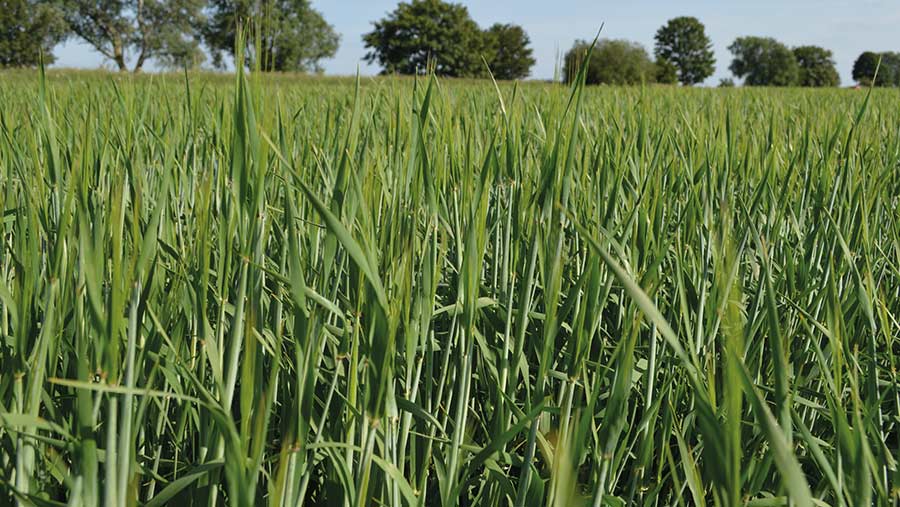Low-skinning spring barley finds favour with Cambs grower
 Firefoxx spring barley © MAG/David Jones
Firefoxx spring barley © MAG/David Jones A spring barley with very low grain skinning is finding favour with major maltsters and distillers, and could become a major variety for distilling use in Scotland.
Grain skinning, or poor husk adhesion, causes problems in the malting process as grains take up water at different rates, and loose husks can block malting sieves.
New malting spring variety Firefoxx is showing very low skinning levels and Cambridgeshire grower Paul Hayes is impressed with the variety in his third season of growing it.
“The variety stands well and yields well, and I’ve never seen it go down, even in last summer’s storms,” he says.
See also: How to grow a better spring malting barley crop
Good yields
The crop has turned in yields of 7.5t/ha in the past two seasons using 140kg/ha of nitrogen fertiliser on heavy fertile silty loams, and this could bode well for growing the variety on light Scottish malting barley land.
Mr Hayes is particularly impressed with its standing power and grain retention in the ear, as last season his oat crops shed grains in the summer storms.
The barley variety has performed well over a range of drilling dates. In his first year of growing the variety in 2019 it was drilled at about the traditional time of 13 March and then in the wet spring of 2020 on 15 April, but both crops yielded 7.5t/ha.
“On this land, if you get a crop in right it will yield. So I would definitely grow the variety again,” he says on his Hundreds Farm, just on the northern edge of the fenland market town of March.
Farm Facts
The P&L Hayes farming business covers 260ha of arable land growing winter wheat, vining peas, sugar beet, spring barley and spring oats

Paul Hayes © MAG/David Jones
Nitrogen use
This season he drilled the variety on 5 April, with a seedbed compound fertiliser containing 70kg/ha of nitrogen, and then applied another 70kg/ha at the two-leaf stage.
After a pre-emergence herbicide, a T1 fungicide was applied, along with a post-emergence herbicide and trace elements. A T2 fungicide was used in late June with the plant growth regulator trinexapac-ethyl (Moddus).
He says the variety harvests well giving good clean samples with a lot of straw and no sign of brackling, or the ears breaking off, and this season’s crop looked very impressive in June and he was hoping for another 7.5t/ha yield.
Breeder’s view

George Goodwin (left) and Paul Taylor (right) © MAG/David Jones
The variety bred by Anglo-German joint venture Elsoms/Ackermann Barley joined the 2020/21 AHDB Recommended List and is provisionally approved for distilling, with a full approval expected after this harvest.
Paul Taylor, head of agriculture at breeding group Elsoms, says two big maltsters and the top distillers like the variety due to its low skinning and high yields for northern growers.
He adds there will be enough seed to meet the need of 10-12% of the Scottish spring barley malting market next season, a market largely dominated by the varieties Laureate, Diablo and Sassy.
“I am confident it will become one of the three main varieties in the distilling market in Scotland,” he says. This is alongside Laureate, while a third may be another newcomer Tungsten.
George Goodwin, cereals and vining peas crop manager at the same breeder, says the variety has shown very low skinning in official malting trials, with levels of 2.9% against a control of Laureate, Diablo, Planet and Concerto at about 5%.
Malting process
Grain skinning is a serious problem in the malting process, as grains without husks take up water and germinate more rapidly than those with firmly adhered husks, leading to uneven malting.
Weather conditions, such as wet and dry spells in the summer, can cause skinning, which can lead to price deductions or even load rejections, while genetics can play a part, with some varieties showing better resistance.
Firefoxx also shows a good yield, outyielding Laureate on the AHDB Recommended List for the north region with a fungicide-treated yield of 103% to Laureate’s 100%, and Sassy down on 99%.
Although Diablo does show the same treated yield of 103%, it is later to mature than Laureate and Firefoxx. The AHDB puts Diablo as maturing two days later than Concerto, while Laureate, Sassy and Firefoxx are only one day later.
Scottish success
Aberdeenshire grower Willie French saw a yield of just under 10t/ha from his Firefoxx spring barley last year and says it was a good healthy crop with little sign of grain skinning.
He grew 47ha of the variety last year for seed and malting, and it stood up well, showed no brackling, while the proportion grown for malting was accepted.
“Last year was a good harvest up here, but it yielded better than any other variety on the farm,” he says.
The variety showed much less skinning than the other three main spring malting varieties Laureate, Diablo and Sassy and was not too late to harvest, he says.
Farming at New Keig, near Alford, 600ft above sea level and 25 miles inland from Aberdeen, he described the yield as “amazingly good”.
This year he is growing 82ha of the variety and again it looks a good healthy crop and he is hopeful for a good yield.
Spring malting barleys for distilling use |
||||||
| Firefoxx | Laureate | Diablo | Tungsten | Sassy | Concerto | |
| Fungicide-treated yield | 103% | 101% | 102% | 103% | 98% | 95% |
| North region | 103% | 100% | 103% | 103% | 99% | 93% |
| Lodging | 7 | 7 | 7 | 7 | 6 | 7 |
Disease resistance |
||||||
| Mildew | 9 | 9 | 9 | 9 | 9 | 9 |
| Rhynchosporium | (5) | 6 | 5 | (4) | 6 | 4 |
| Brown rust | 4 | 5 | 5 | 4 | 5 | 5 |
| Listed | 2020 | 2016 | 2018 | 2020 | 2016 | 2009 |
Three spring variety have full approval for malt distilling by the Malting Barley Committee – these are Laureate, Sassy and Diablo. Two others have provisional approval – Tungsten and

